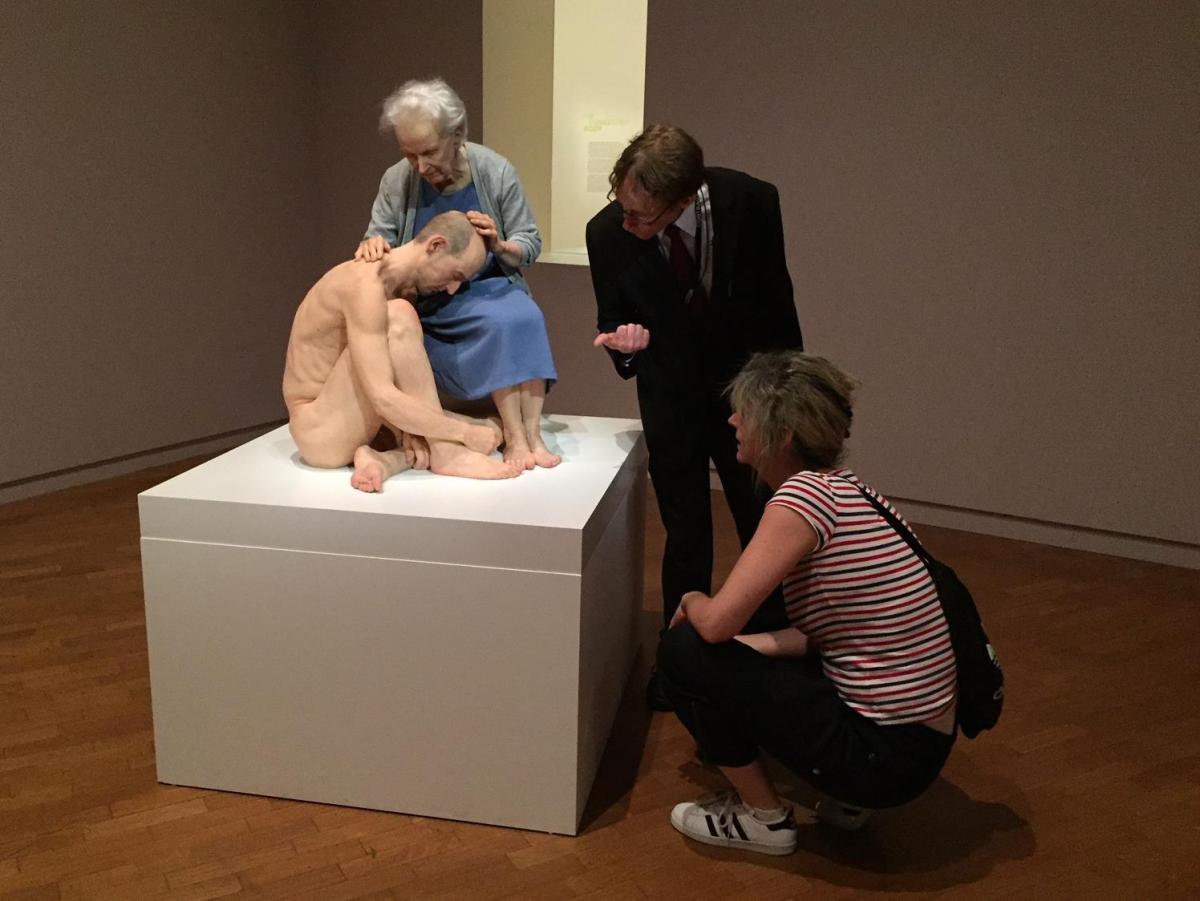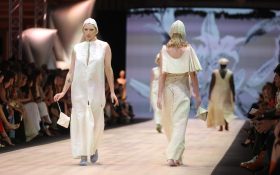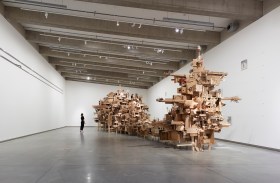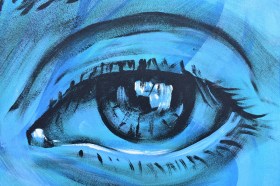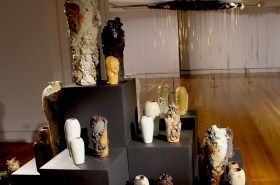Hyper Real – the title says it all, this phenomenon within sculpture where our sense of awe almost enters a world of disbelief as we confront more-real-than-real portraits of humanity.
The National Gallery of Australia (NGA) has curated a fantastic exhibition that does not disappoint. I was a little slow at making the trip to Canberra, quietly thinking to myself, how many Sam Jinks, Ron Mueck and Patricia Piccinini sculptures could I really stomach in one show, not that I hold anything against their work individually, but en masse?
This exhibition however both surprised and excited, and I was delighted to be thrown off guard and proven wrong.
What Hyper Real offers the viewer is context, something so often overlooked in major exhibition of a blockbuster style.
The first sculpture that visitors encounter is by Macedonian artist, Zharko Basheskio Ordinary man (2009-10), his torso seemingly pushing through the gallery floor popping up to be part of the action.
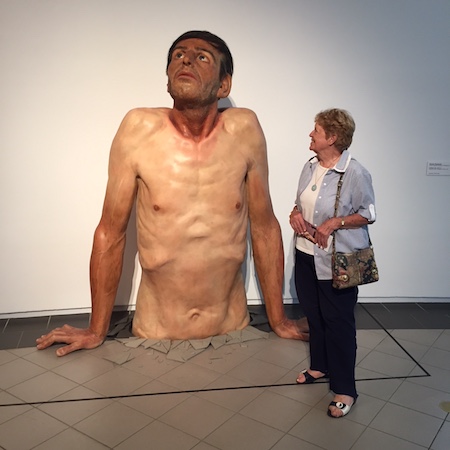
Larger than life Zharko Basheskio’s sculptures greets viewers at the entry to the Hyper Real exhibition; Photo ArtsHub
It hints of the unexpected in this exhibition, both in terms of its international reach and its mapping of time across a genre that first came to emergence in the 1960s with the introduction of new synthetic materials, which is quickly confirmed in the first gallery.
Punters are faced with an incredible line-up of “people” loitering in the space: pioneering hyperreal artist George Segal (USA) with the two works Standing woman looking into mirror (1996) and Seated woman reading (1998-99); Duane Hanson’s (USA) iconic pieces, Two workers (1993) and Woman with a laundry basket (1974); Daniel Firman’s (France) Caroline (2014) and Jan Nelson (Australia) Strange days (2013) completing the group.

Installation view of Duane Hanson’s Two workers (1993) and Woman with a laundry basket (1974) with “live” NGA security guard; Photo Artshub
The next main gallery space explores the naked body – its vulnerabilities, ideal beauty, sexualisation, and sense of classicism – and plays with our sense of unease as a visitor playing the voyeur.
The collection asks: ‘By blurring the line between reality and representation (many of these sculptures are made from actual body casts), hyperrealism emphasizes the contrived nature of the unclothed body-and the contested distinction between nakedness and nudity.’
Works by Marc Sijan (Serbia) alongside those of John DeAndrea (USA), Jamie Salmon, and Paul McCathy’s series That Girl (T.G. Awake) (2012-13) – a group of three life-sized sculptures of the same woman displayed on tables with saw-horse legs in a sitting position – her legs spread to varying degrees.
Together, these static variations reference the magical effect by which a series of still images can be joined together to become film. ‘T.G. Awake’ found its origins in drawings that McCarthy made of his wife Karen in the 1960s and relates to the first White Snow pencil drawings of 2009. (T.G. is an acronym for ‘That Girl’ and refers to another feminine icon, aspiring actress namesake of a hit 1960s situation comedy)
‘Life casting liberates the literal through a kind of unifying monotone,’ McCarthy has said. ‘It creates a different representation of the original thing that lets me explore where reality and abstraction intersect’.
What is a real curatorial success across this exhibition is its design – the way the visitor is led through the exhibition and at times forced to engage with, and intersect installations. Sun Yuan and Peng Yu’s installation Old people’s home (2007), and at another point in the exhibition Piccinini’s installation of Bootflower (2015) and Meadow (2015), are good examples of this bodily engagement.
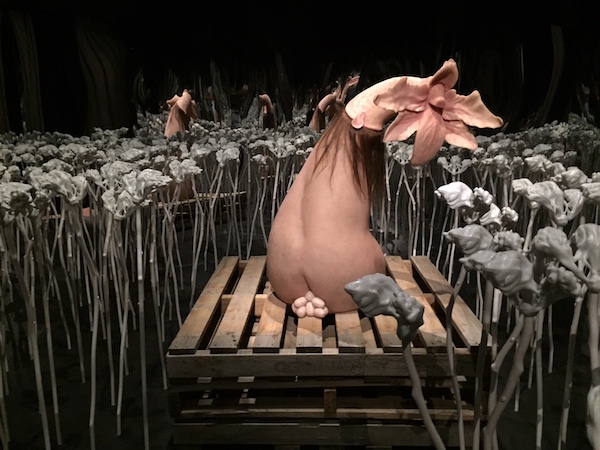
Visitors have to move their way through Patricia Piccinini’s installation Meadow to continue viewing the exhibition; Photo ArtsHub
Yuan and Yu’s installation of aging world dictators in wheelchairs is a crowd pleaser, activated by sensors and moving around the space in a kind of heroic ballet sequence, what they describe as a ‘mechanical theatre’.
At once the work is both menacing – even haunting – but then is laced with a great sense of humour and dark critic of world power structures.

Installation view Sun Yuan and Peng Yu’s installation Old people’s home (2007); Photo ArtsHub
At the centre of the exhibition are three almost mini-solos of work by Sam Jinks, Ron Mueck and Patricia Piccinini, including a newly-commissioned and acquired work by Jinks. What is immediately felt is the bounce between scale – from Mueck’s looming Wild Man (2005) to Jinks’ intimate new piece The deposition.
Again you can see through these rooms that have been created in the gallery, with windows that allow the viewer to look through, recall and connect with other artists working in this genre across the exhibition.
Another tick goes to Hyper Real for its capacity to move our perceptions forward. The success of artists such as Jinks and Mueck has almost conditioned us to a formulaic way of reading hyper real sculpture. In this exhibition however, that notion of the extreme real is also played out in video, animation, virtual reality, and bio-art, which advance the genre to a contemporary dialogue of now.
As the gallery states: ‘The contemporary hyperreal resides at the nexus of art, psychology, science, literature, technology and philosophy.’
Piccinini ushers the way with her three-channel video, The breathing room (2000). Of note is Tony Ourseler’s (USA) Incubator (2003) and Shaun Gladwell’s new VR work Orbital vanitas (2017) and Russian Collective AES+F’s quintessential digital work presented in a drum-like room to an operatic sound track, Inverso mundus (2015) (translated, the world turned upside down) – all which explore the notion of the post human and virtual body.
You still have time to catch Hyper Real, and in many ways it is an exhibition that is very timely and shouldn’t be missed. It reintroduces us to the ideas of empathy and acceptance as common human attributes, which seem to have become so fragile in our contemporary society.
Rating: 5 out of 5
Hyper Real
Curator: Jaklyn Babington, Senior Curator of Global Contemporary Art, NGA
20 October 2017 – 18 February 2018
National Gallery of Australia
Canberra, ACT
